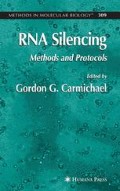Abstract
The majority of metazoan genes encode pre-mRNAs that are subject to alternative splicing. For example, it has recently been estimated that as many as 74% of human genes encode alternatively spliced mRNAs (1). An alternatively spliced gene can generate anywhere from 2 different isoforms to as many as 38,016 isoforms in the case of the Drosophila Dscam gene (2). Thus, alternative splicing serves to greatly expand the diversity of the proteins encoded by a genome (3).
Access this chapter
Tax calculation will be finalised at checkout
Purchases are for personal use only
References
Johnson, J. M., Castle, J., Garrett-Engele, P., et al. (2003) Genome-wide survey of human alternative pre-mRNA splicing with exon junction microarrays. Science 302, 2141–2144.
Schmucker, D., Clemens, J. C., Shu, H., et al. (2000) Drosophila Dscam is an axon guidance receptor exhibiting extraordinary molecular diversity. Cell 101, 671–684.
Graveley, B. R. (2001) Alternative splicing: increasing diversity in the proteomic world. Trends Genet 17, 100–107.
Celotto, A. M. and Graveley, B. R. (2002) Exon-specific RNAi: a tool for dissecting the functional relevance of alternative splicing. RNA 8, 718–724.
Hutvagner, G. and Zamore, P. D. (2002) RNAi: nature abhors a double-strand. Curr. Opin. Genet. Dev. 12, 225–232.
Sijen, T., Fleenor, J., Simmer, F., et al. (2001) On the role of RNA amplification in dsRNA-triggered gene silencing. Cell 107, 465–476.
Nishikura, K. (2001) A short primer on RNAi: RNA-directed RNA polymerase acts as a key catalyst. Cell 107, 415–418.
Acknowledgments
The authors thank members of the Graveley lab for discussions. This work was supported by NIH grants to B.R.G.
Author information
Authors and Affiliations
Editor information
Editors and Affiliations
Rights and permissions
Copyright information
© 2005 Humana Press Inc.
About this protocol
Cite this protocol
Celotto, A.M., Lee, JW., Graveley, B.R. (2005). Exon-Specific RNA Interference. In: Carmichael, G.G. (eds) RNA Silencing. Methods in Molecular Biology™, vol 309. Humana Press. https://doi.org/10.1385/1-59259-935-4:273
Download citation
DOI: https://doi.org/10.1385/1-59259-935-4:273
Publisher Name: Humana Press
Print ISBN: 978-1-58829-436-4
Online ISBN: 978-1-59259-935-6
eBook Packages: Springer Protocols

